Creative Drawing Ideas for Kids
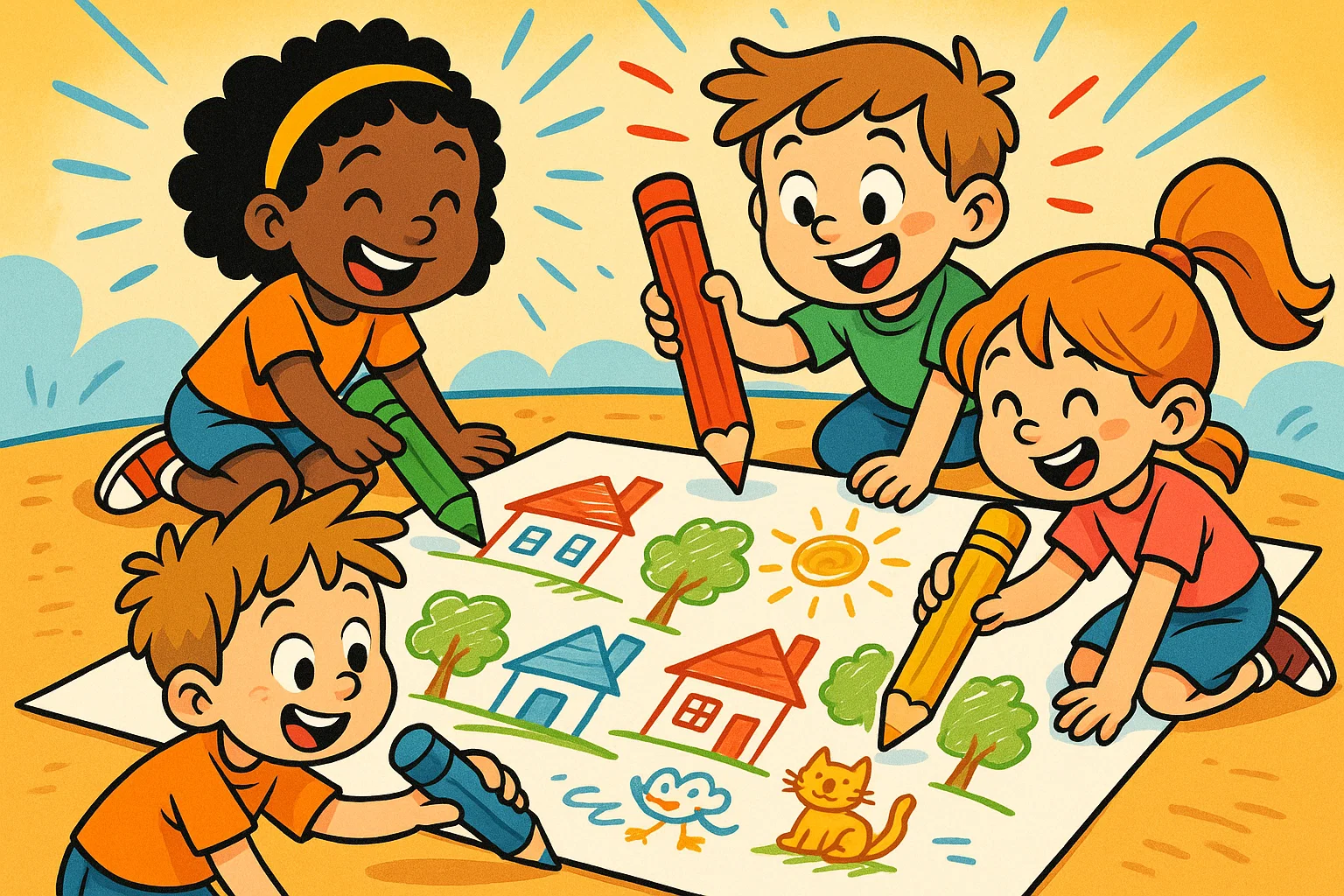
Drawing helps kids express creativity, build fine motor skills, and process emotions. The biggest challenge often isn’t talent, but knowing how to start.
This guide offers fun drawing ideas and step-by-step tutorials for both classrooms and home, tailored to different ages and skill levels. With the right guidance, even a simple pencil or crayon can spark confidence and inspire a lifelong love of art.
Easy Drawing Ideas for School Kids
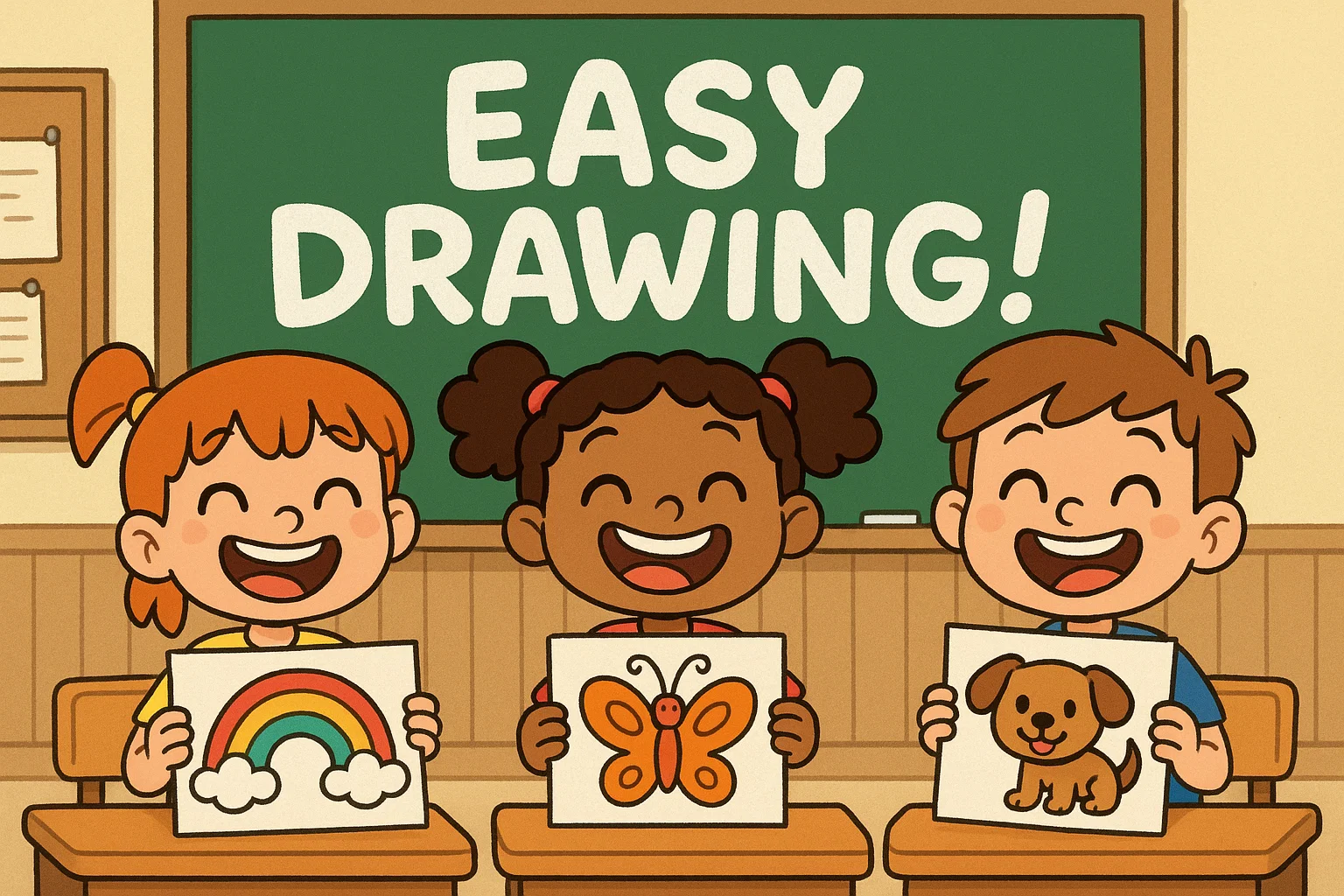
Getting started shouldn’t be intimidating. For a young student, the most engaging projects are often those that start with basic geometric shapes and progress naturally. These simple drawing concepts are fantastic for building early drawing skills.
House Drawing
A house is a timeless subject that is easy to draw and provides a great introduction to perspective and composition.
- Start by drawing a large square or rectangle for the main part of the house.
- Next, begin by sketching a triangle on top for the roof.
- Add smaller squares or rectangles for windows and a door.
- Once the basic structure is complete, encourage your kids to draw details like curtains, roof tiles, or even a chimney with a wisp of smoke.
Tree Drawing
From simple circles to complex branches, trees offer varied drawing challenges. Learning to draw different types of trees helps kids observe nature and understand organic shapes.
| Tree Type | Starting Shape | Key Feature to Add |
| Simple Tree | A rectangle trunk and a large circle/oval for the canopy. | Wavy line for the ground, two lines for a simple path. |
| Leafy Tree | A thick, slightly tapering trunk. | Use scribble or short, overlapping curves for realistic-looking leaves. |
| Pine Tree | A straight trunk. | Overlapping triangles stacked on top of each other for the needles. |
Animal Drawing
Kids love drawing the cat’s playful pose, a cuddly puppy, or a friendly bunny. Animal drawing is a delightful way for kids to practice drawing curved lines.
- Draw a cat: Start by drawing a large circle for the head and a slightly smaller oval for the body. Add two small triangles for ears. Use the simple shapes as a foundation for a cute and cuddly feline.
- Draw a dog: Try different dog breeds by varying the ears (floppy or pointy) and the snout. A simple oval for the body and a circle for the head is the perfect starting point.
- Draw a puppy or bunny: These are great because they rely heavily on rounded shapes.
Flower Drawing
Flowers are a joyful subject for kids to draw, especially when introducing colour. Sunflowers, tulips, and simple daisies are great options. A common approach is to begin by drawing a large circle for the center and then adding petals around it. Encourage them to add stems and leaves for a complete picture.
Self-Portrait Drawing
This drawing activity is excellent for developing awareness and observational drawing skills. Guide children to focus on basic face proportions—eyes about halfway down the head, ears between the brow and the nose. It doesn’t have to be perfect; the goal is to observe and represent. This is a powerful way for kids to build self-expression.
Fun Drawing Projects for School Classes
Art in a school setting thrives on collaborative and thematic projects. These fun and creative ideas encourage imaginative drawing and teamwork.
Rainbow Drawing
A rainbow drawing project is a classic for teaching colour mixing and sequencing. It’s a wonderful, vibrant activity for the classroom.
- Start by drawing two large, wide-set clouds on either side of the page.
- Use an arc shape to connect the clouds.
- Guide students to fill the arcs with the seven colors of the rainbow (Red, Orange, Yellow, Green, Blue, Indigo, Violet).
Rocket Ship Drawing
Perfect for science or space-themed lessons. This project involves clear geometric shapes and allows for plenty of individual customization. Students can start by sketching a long oval and adding fins, windows, and flames at the bottom for propulsion.
Mermaid or Unicorn Drawing
Encourage fantasy with a mystical drawing project. These projects are particularly popular with kids that will help them escape into a world of pure imagination.
- Draw a mermaid: Start by sketching a simple head and torso. The fun part is the tail—use a curved line for the body, ending in a large, fan-shaped tail fin. Encourage sparkling scales and flowing hair.
- Draw a unicorn: Begin with a simple horse shape and add the defining element: a spiraling horn on the forehead.
Cartoon Character Drawing
Show kids how to simplify a popular cartoon character into basic shapes. For instance, a Minion is primarily an oval with goggles, and Baby Groot is essentially a stick figure with bark texture and big eyes. This helps students understand how professional artists simplify complex forms.
Group Drawing Games
Collaboration is key!
- Exquisite Corpse: Each child draws a part of a figure on a paper section, folds it over, and passes it on. The reveal of the final, often hilarious drawing is always a highlight.
- Doodle Chains: One child starts a doodle, and the next child must continue it, turning the original shape into something new.
Step-by-Step School Drawing Tutorials
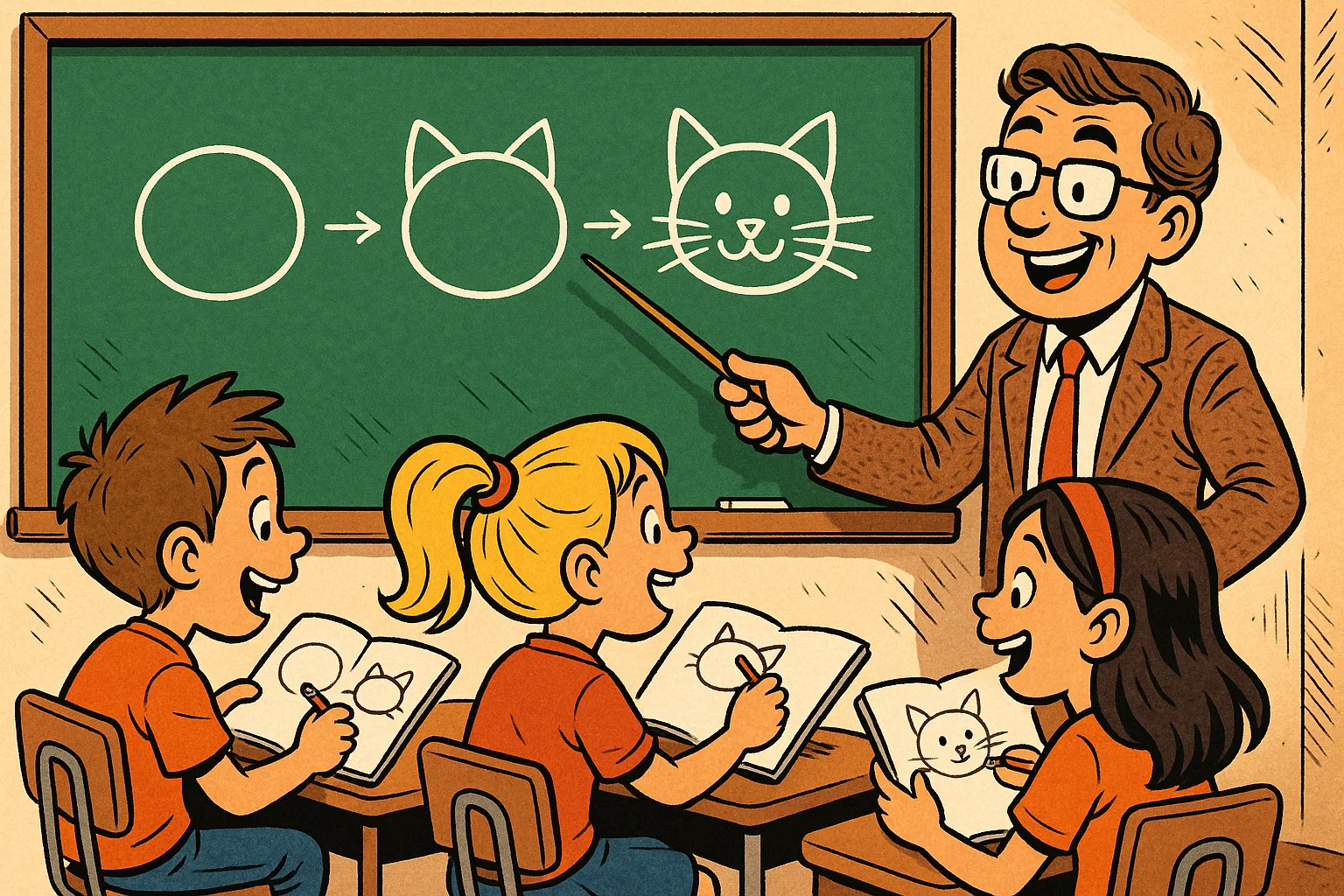
Structured drawing tutorials are excellent for building confidence. They break down a seemingly complex image into manageable, easy step-by-step instructions.
How to Draw a Butterfly
- Start by drawing a large oval for the body.
- Add a small circle on top for the head.
- Sketch two large, symmetrical wings. They can be slightly curved or shaped like an artist’s palette.
- Add antennae and colorful patterns (dots, swirls) using crayon or colored pencils.
How to Draw a Dinosaur
A simplified Tyrannosaurus Rex or Brachiosaurus is a fun prehistoric drawing.
- Begin by drawing a large, curved neck and a bean-shaped body.
- Add sturdy legs (like thick columns).
- Draw a long, tapering tail and a fierce head. This is a great way to integrate art into a history or science lesson.
How to Draw a Bird
- Start by sketching two overlapping ovals—one for the head and one for the body.
- Add a triangle for the beak.
- Draw a large wing shape on the side and two simple lines for legs. Encourage them to add feathers using short, overlapping strokes.
How to Draw a Dragon
A simplified, friendly dragon is perfect for this age group.
- Begin by sketching an S-curve for the neck and body.
- Add a large oval for the belly and small, bat-like wings on the back.
- A spiked tail and a smile make this fantasy creature less intimidating.
How to Draw a Boat
- Start by drawing a simple curved line (like a wide, shallow U-shape) for the hull.
- Add a vertical mast (a tall, straight line).
- Sketch a simple triangle for the sail. This project is perfect for introducing basic geometric concepts.
Creative Drawing Ideas by Age Group
The complexity and focus of drawing for kids should evolve as their cognitive and motor skills develop.
Drawing for 5–7 Year Olds
At this stage, art is mostly about exploration and scribble. Fun activities focus on sensory experiences and basic shape recognition.
- Finger Paintings: Simple, tactile creations using tempera paint.
- Scribble Flowers: Have them scribble circles and then turn the scribble into a vibrant flower by adding a stem.
- Hand Tracing: Trace their own hand and turn it into a turkey, a star, or a monster.
Drawing for 8–10 Year Olds
Children are beginning to focus on realism and detailed planning. They enjoy step-by-step drawing guides and thematic projects.
- Cartoon Characters: Replicating simple characters from memory or a reference.
- Rocket Ships: Adding details like rivets, hatches, and complex flame patterns.
- Optical Illusions: Simple drawing two parallel lines that seem to diverge.
Drawing for 11–12 Year Olds
This is the age to introduce more advanced concepts like shading and perspective. Children begin focusing on drawings that look realistic or stylistically unique.
- Perspective Drawings: Learning a simple one-point perspective for drawing roads, rooms, or railway tracks.
- Shading Exercises: Using cross-hatching or blending with a pencil to give objects (like an apple or a cube) a 3D effect.
- Portrait Basics: Learning about the structure of the skull and the basic proportions of the head.
School Drawing Activities and Challenges
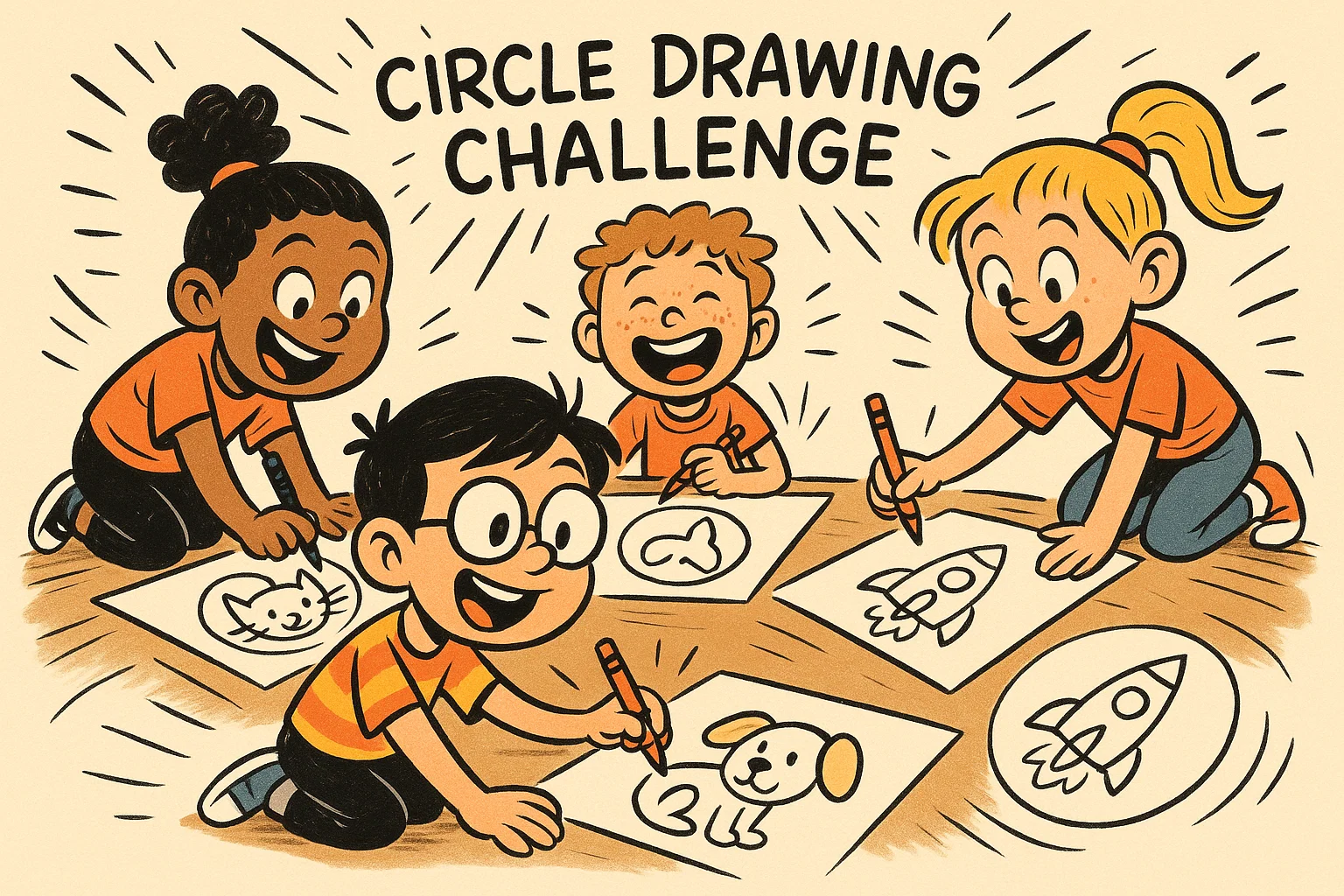
Engaging drawing challenges help build technical skill and encourage out-of-the-box thinking.
Circle Drawing Challenge
Show kids how to start by drawing a large number of circles on a page. The challenge is to turn each circle into a different object (a sun, a button, a face, a coin, a planet, etc.) without adding any other shapes to the circle itself.
Hand Tracing Ideas
Beyond the simple turkey, kids can turn their hand outlines into a forest of trees, a school of fish, or an elaborate monster. This is a brilliant creative activity that starts with a physical connection to the art.
Optical Illusion Drawing
Introduce simple illusions. For example, drawing a series of concentric squares and then curving the connecting lines to create the illusion of a tunnel or a hole. This helps kids understand how line and perspective affect what the drawing looks like.
Sticker or Scratch Art
Using specialized scratch art paper or simply drawing with wax crayon and then covering the whole thing with black paint can lead to exciting, easy-to-create pictures. The child scratches away the top layer to reveal color underneath.
Daily Sketch Challenge
Encourage kids to keep a small sketchbook and choose one mundane object to sketch every day—a shoe, a glass, a stapler. This builds observational drawing skills and a daily habit of practice. This consistent practice is key to learning to draw.
Tips for Teachers and Parents
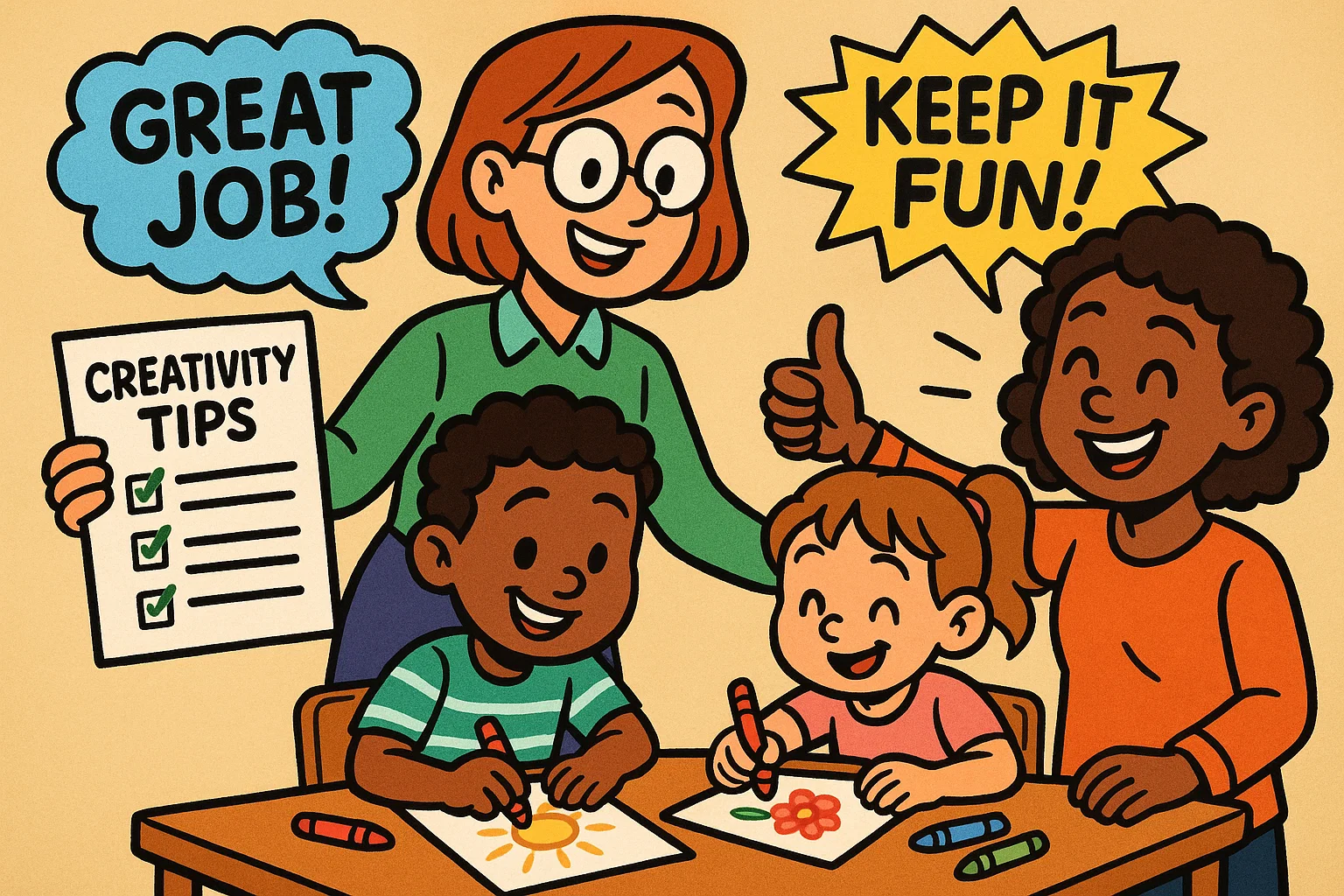
Your role is to facilitate, not criticize—the environment you create is just as important as the materials you provide. The environment you create is as important as the materials you provide.
How to Encourage Creativity
Avoid pressuring your child to create a “perfect” picture.
- Focus on the Process: Praise effort and imaginative choices over the final product. Phrases like, “I love how you chose those colors!” are more helpful than “That looks exactly like a horse.”
- Provide Open-Ended Materials: Offer a variety of mediums (pencil, charcoal, crayon, paint, black marker) and let the child choose.
- Ask Guiding Questions: Instead of telling them what to draw, ask, “What story is your picture telling?” or “How does that shape make you feel?”
Mess-Free Drawing Activities
For classrooms or kids who need tidy, low-mess activities:
- Dry-Erase Boards: Great for quick doodles and easy erasing.
- Water-Color Pencils: Offer the versatility of colour pencil with the option to add water for a painting idea.
- Digital Drawing Apps: Offer a mess-free drawing experience on a tablet.
Using Drawing in School Projects
Art isn’t just for art class.
| Subject | Drawing Integration |
| Science | Drawing the life cycle of a butterfly or the parts of a plant (botanical drawing). |
| History | Sketching an ancient artifact, a historical figure, or a map of a key location. |
| Language Arts | Illustrating a scene from a story they are reading or designing a cover for a book report. |
Best Drawing Kits for School
Always prioritize non-toxic, age-appropriate materials. A basic kit for kids of all ages should include:
- Pencils: Good-quality pencils suitable for shading.
- Erasers: Both plastic and kneaded.
- Crayons and Markers: A 24-pack of washable, non-toxic markers.
- Sketchbook: Acid-free paper, around 8.5″ x 11″.
Frequently Asked Questions
What can a 7-year-old draw easily?
A 7-year-old can easily draw simple objects that rely on basic shapes: houses, cars, stick figures, simple animals (draw a cat, dog, or bunny), and flowers. Focus on easy to draw subjects that have high visual appeal and a clear starting point.
How to teach drawing in school?
To teach drawing in school, use a structured approach:
- Introduce a Topic: A simple object like an apple.
- Deconstruct the Subject: Identify the basic shapes (the apple is a sphere).
- Step-by-Step Drawing: Guide the class through the process, focusing on technique, not perfection.
- Encourage Personalization: Have students add their own colors, textures, or backgrounds.
What are the easiest things to draw for beginners?
The easiest things to draw for beginners are geometric shapes (cubes, spheres, pyramids), simple fruits (apples, oranges), and basic landscapes (tree step by step, sun, grass). These simple drawing ideas for kids build foundational knowledge.
Why is drawing important for kids in school?
Drawing is important for kids in school because it:
- Enhances fine motor skills and hand-eye coordination.
- Fosters problem-solving and critical thinking (e.g., how to fit a large object on a small page).
- Allows them to express their creativity and process emotions non-verbally.
- Improves focus and attention span—a great complement to academic subjects.
